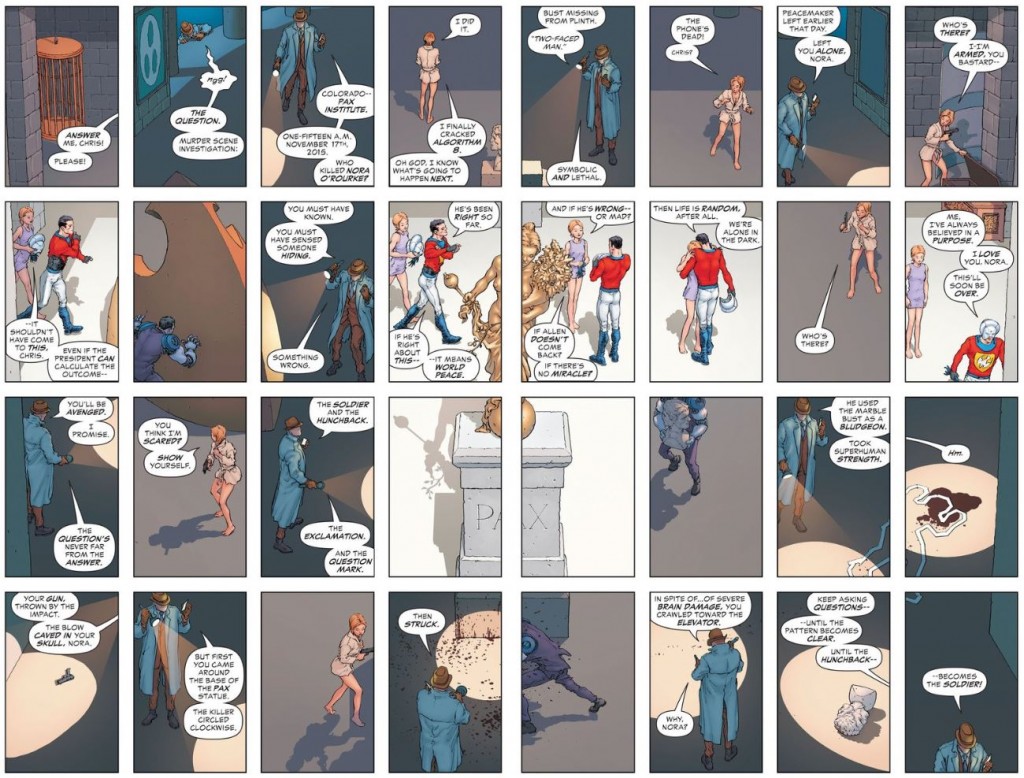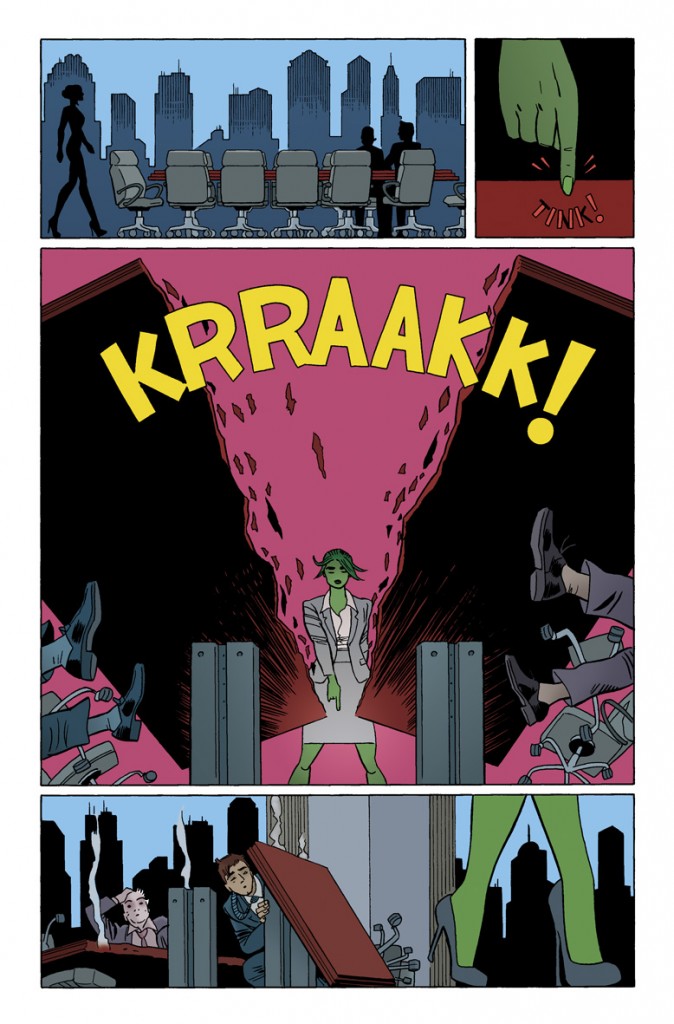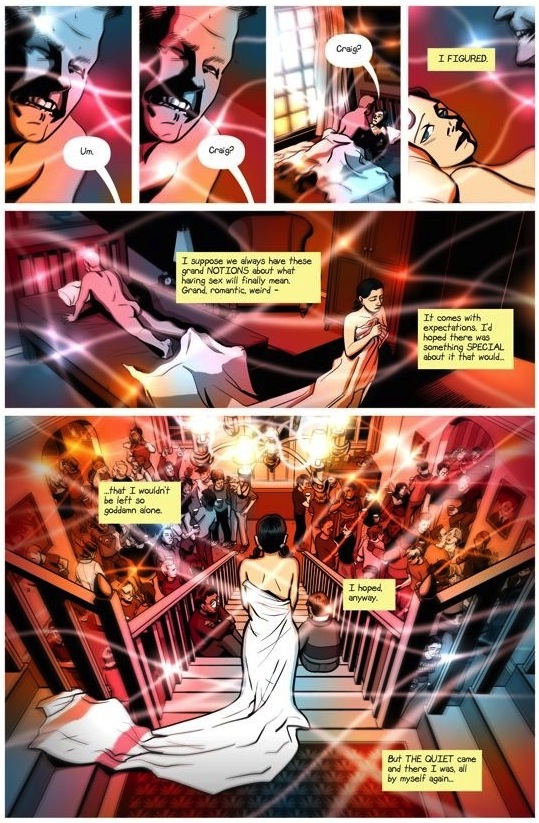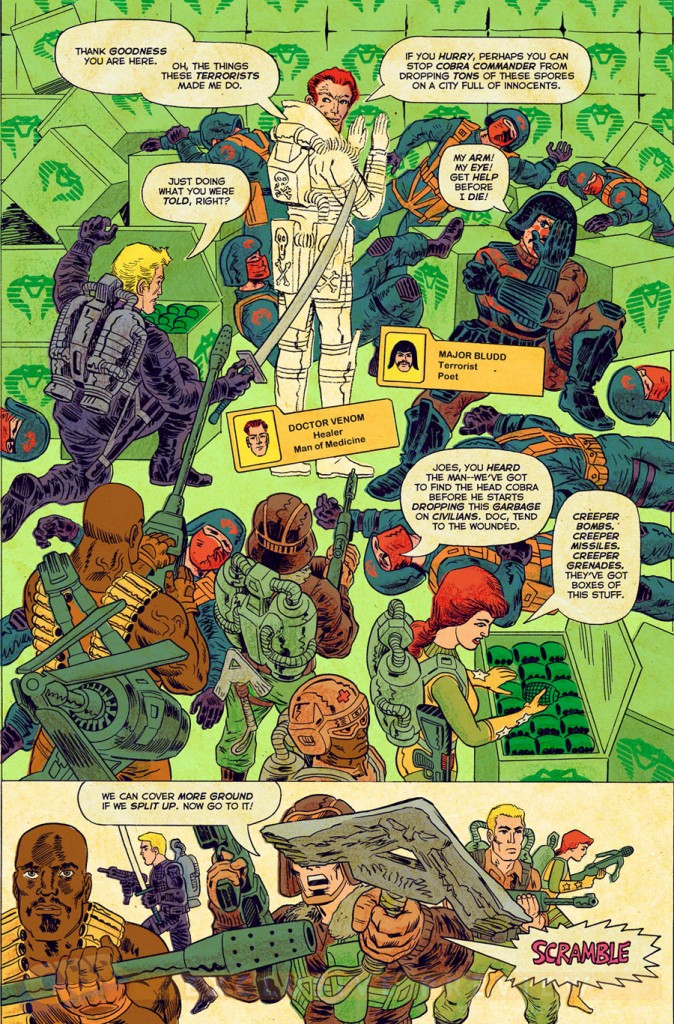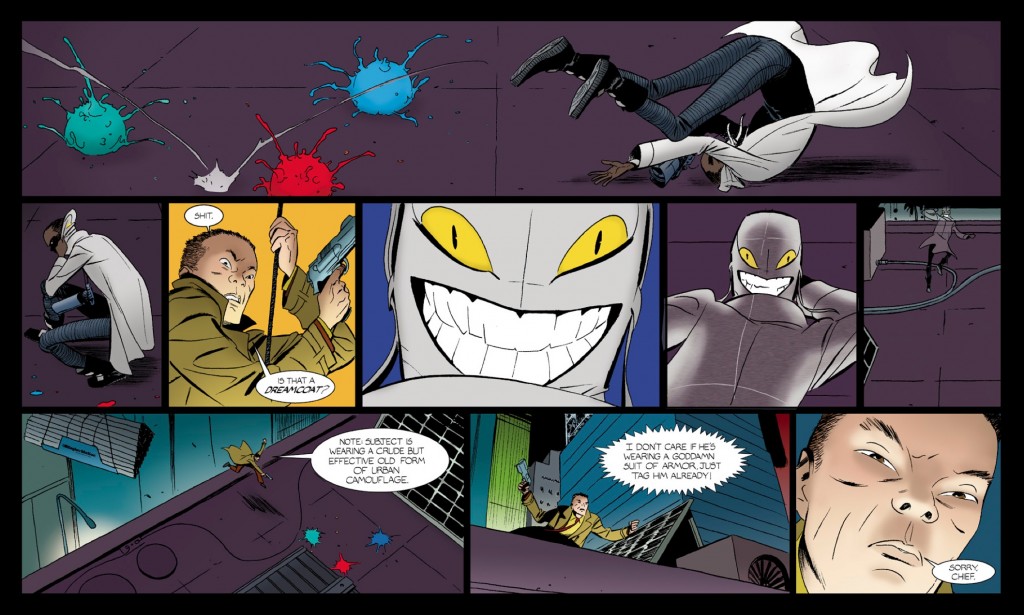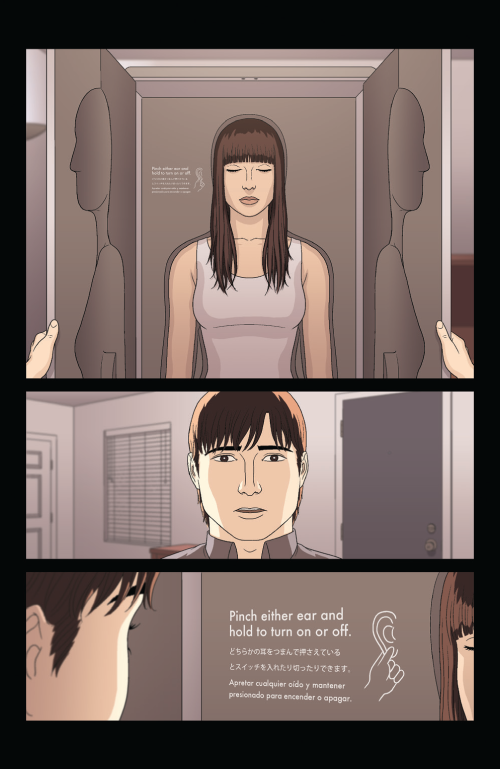Looking back at the comics that came out this year, there’s no shortage of great work. From capes and tights superheroics to more grounded stories of the human experience, 2014 was a damn good year for an artistic medium that’s in the midst of serious change and growth. Not only is the variety of comics we’re seeing evolving (half of the books on this year’s list tell the stories of very different kinds of female leads), but publishers like Image, Monkeybrain, and Panel Syndicate are changing the way comics are made and enjoyed. Deadshirt’s staff picks for the top ten ongoing titles and graphic novels published this year wasn’t easy to compile, but only because 2014 saw so many incredible comics. It’s a good time to be a comics reader; I think this list is proof of that.
– Max Robinson, Comics Editor
1. The Multiversity (DC Comics)
2014 will always be the year DC finally cut the shit and gave us a big, fat apology for all the rampant creative idiocy they’ve repeatedly perpetrated on their readers. No, they didn’t undo the New 52 reboot, make Amanda Waller fat, or stop sending Scott Lobdell paychecks. Instead, they facilitated the release of Grant Morrison’s grand statement on the DCU, superhero comics, and life itself. Morrison’s vision of the vast expanse of DC’s multiverse, a succession of highly ambitious pilots each set on a different parallel Earth, reads like one man trying his goddamndest to convince the gatekeepers how special the IP they possess has the potential to be.
Each issue thus far has felt like a statement addressing the various symptoms of the illness plaguing modern superhero stories, from the lack of diversity addressed in the first issue’s framing chapter up to taking the rest of the industry to task for not dreaming a little bigger in “Pax Americana.” “Society of Super-Heroes” harkens back to the pulp beginnings of the genre in a way that sidesteps nostalgia and makes a case for bringing back the 1930s for good. “The Just” comes off as disturbingly postmodern, exploring youth in a way that would make Kieron Gillen jealous. That Grant is outdoing himself in terms of pure craft (his scripts benefit from rewrite after rewrite, removed from the grind of a monthly publication schedule), his artistic collaborators (Reis, Sprouse, Oliver, Quitely) match and often exceed his skills.
While it’s easy to get caught up looking for “fuck Alan Moore” symbolism or obsessing over the detailed minutiae in every passing frame, there’s a palpable serving of heart that makes Multiversity resonate so much. There’s nothing wrong with rereading every issue for scholarly analysis, particularly since the book is so dense, (really turning that $4.99 price point into a bargain) but after those cursory reference-hunting sessions, when you sit with it and really just experience it as 40 pages of pure art, love and invention? That’s why it’s our comic of the year. It’s the platonic ideal of superhero storytelling delivered by a series of creative teams all operating at the height of their powers. We long for a time when books this good and this fun are the rule and not the exception.
– Dominic Griffin
2. Avengers/New Avengers (Marvel)
Jonathan Hickman’s expansive run on Marvel’s inter-connected Avengers titles is twisting in tighter and tighter on itself as we head towards the Secret Wars event next year, and that intertwining and raising stakes has provided some of the best comics stories of the year. All along, Hickman has made these books as much about the teams themselves and their internal dynamics as anything else, and asked the fundamental question of what it means to be an Avenger. From the phenomenal time-traveling arc in Avengers (gorgeously drawn by Leinil Francis Yu) to the heartbreaking “Great Society” arc in New Avengers, Hickman has explored who these heroes are, and what they’re willing to sacrifice for their vision of peace. Now, with “Time Runs Out,” the books have converged into a complex, engaging story of hero versus hero. It’s been a good year to be an Avengers fan.
– Joe Stando
3. Seconds (Random House)
 The highly anticipated follow-up to the modern classic Scott Pilgrim series, Seconds is Bryan Lee O’Malley’s most mature work to date. The story of Katie, a prickly, spikey-haired chef who rewinds time to fix her mistakes with a batch of magic mushrooms, Seconds is a fun mix of real-world problems and magical solutions. O’Malley creates a beautiful mini-mythology in the characters of the house spirits, the sometimes helpful, sometimes dangerous beings that only Katie can see, but the book’s most compelling moments are rooted in Katie’s psyche. Katie is an immensely relatable protagonist, even when she isn’t particularly likeable. She’s driven and passionate, yet plagued by self-doubt and the overwhelming need to make everything in her life perfect. After all, who would turn down a chance to undo our mistakes, whether it’s saving a relationship, or just making up for that one night we wasted watching Netflix?
The highly anticipated follow-up to the modern classic Scott Pilgrim series, Seconds is Bryan Lee O’Malley’s most mature work to date. The story of Katie, a prickly, spikey-haired chef who rewinds time to fix her mistakes with a batch of magic mushrooms, Seconds is a fun mix of real-world problems and magical solutions. O’Malley creates a beautiful mini-mythology in the characters of the house spirits, the sometimes helpful, sometimes dangerous beings that only Katie can see, but the book’s most compelling moments are rooted in Katie’s psyche. Katie is an immensely relatable protagonist, even when she isn’t particularly likeable. She’s driven and passionate, yet plagued by self-doubt and the overwhelming need to make everything in her life perfect. After all, who would turn down a chance to undo our mistakes, whether it’s saving a relationship, or just making up for that one night we wasted watching Netflix?
But, lest this sound too angsty, Seconds is an extremely funny, clever book, and it exhibits all of O’Malley’s strengths as an artist. His character designs are charming and unique, and he has an eye for fashion that’s rarely matched in the current comics industry. His artwork is taken to the next level with colors by Nathan Fairbairn that are warm, inviting, and perfect for the book’s mystical mood. Seconds mixes fantasy and reality in a bubbling cauldron to produce something special.
– Kayleigh Hearn
4. She-Hulk (Marvel)
Charles Soule’s She-Hulk has drawn numerous comparisons to Matt Fraction’s Hawkeye and Mark Waid’s Daredevil because all three explore characters we usually see dealing with supervillains now dealing with neighbors and landlords—often employing deadpan snark along the way. While nothing can touch Hawkeye’s level of side-eye sarcasm, She-Hulk has some important advantages where it counts. Discriminated against for her appearance both by employers and potential landlords, Jennifer Walters is forced to do things the hard way, granting myriad comedic opportunities for our exasperated protagonist. Soule knows exactly the situations to put Walters in to let her shine, whether it’s fighting for Dr. Doom’s awful son’s asylum bid, or drunkenly prowling with her old pal Hellcat. All the while, an intriguing dramatic, legal plot is unfolding with far-reaching repercussions for some of our favorite heroes, including She-Hulk. The comedy and the drama are perfectly balanced, and, while I’m sad to see Soule’s run come to an end, I’m glad to see it happen only after his initial plan has run its course. Soule’s She-Hulk is an excellent, self-contained story capable of engaging anyone who likes good comics, no matter their level of background knowledge.
– Cameron DeOrdio
5. Ms. Marvel (Marvel)
A Ms. Marvel fanbase was born before the first issue was even released, based on the prospect of a superhero that is female, Muslim, and a person of color, but the novelty of these characteristics comprise only the surface of Kamala Khan. After being exposed to a strange mist, Kamala emerges as a shapeshifter. Unlike other heroes with dark origin stories, Kamala hasn’t experienced a great tragedy that motivates her to make the world a better place, she’s simply a good person that wants that anyway. She has a strong sense of family and community around her, and she strives to live up to the great deeds of the superheroes she admires. Ms. Marvel is a book that has done everything right from the get-go thanks to a strong creative team. Adrian Alphona’s eye for crafting dynamic fight scenes and streetwise teens with style is appropriate for a young hero fumbling with her new powers. Equally fitting are Jake Wyatt’s guest issues that use Ms. Marvel’s rubbery “embiggening” powers to turn her into an endearing, cartoonish fan girl freaking out over her first team-up. At the foundation, writer G. Willow Wilson breathes life into a character that is herself a fan, just like her readers, and who has become Marvel’s biggest breakout superhero in recent memory.
– Sarah Register
6. Sex Criminals (Image)
I think the best and most accurate thing I can say about Sex Criminals is that it makes me feel better about myself, and less alone.
For all we talk about sex-positivity and slut-shaming and social progress, sex still isn’t a topic you see addressed very often in non-pornographic fiction, and certainly not with any nuance or detail. It’s a plot device that happens, passively, and perhaps someone gets jealous or it’s used as a shorthand for a consummation of emotional intimacy, but what that sex is and what it means to the characters is almost always obscured. So it’s a huge relief that Matt Fraction and Chip Zdarsky’s superlative Sex Criminals exists, because it’s all about what happens in those interstitial, ignored moments. It discusses kink boundaries, sexual oppression, the all-too-common dilemma of the inverse relationship between antidepressant medication use and sex drive, and, most importantly, the unique sense of time dilation and forced solipsism that occurs at the moment of orgasm. It’s a book that takes the parts of you you’re told to be ashamed of, puts them out in the light, and shows you that not only does everybody have them but that everybody celebrates them. It’s hysterical, sweet, thoughtful, life-affirming, and beautifully drawn and designed, the result of two artists at the top of their craft. It supersedes its original sex-comedy remit into one of the most imaginative, original, most heartfelt comics on the stands. It’s impossible not to recommend to anyone with an open mind, an open heart, and a powerful thirst. More than any other comic in 2014, Sex Criminals made me feel, and I’m insanely grateful for its existence.
– David Uzumeri
7. Transformers vs. G.I. Joe (IDW)
After finishing up his epic work with Joe Casey on Godland, Tom Scioli was publicly thinking about throwing in the towel on his comics career. Thank goodness he didn’t. Co-writing (with John Barber) and drawing Transformers vs. G.I. Joe, Scioli has successfully redefined the word “crazy” when it comes to describing comics. Starting with their Free Comic Book Day zero issue, two Transformers stumble into a battle between G.I. Joe and the Ruthless Terrorist Organization Cobra, leading humanity and robotkind to clash when the entire planet Cybertron comes to our solar system for a visit. G.I. Joe sends their own invasion force to the robot planet to explore and defeat this new transforming robot menace, and much insanity ensues. Scioli’s art has always drawn comparisons to the work of Jack Kirby, and this book is no different. It successfully mashes up 70s Kirby looks and ideas with both the Marvel comics and cartoon continuities of both G.I. Joe and Transformers to create something fresh and new. Everything in this book is different from what has come before, yet is still familiar and true to the properties involved.
– Jason Urbanciz
8. Moon Knight (Marvel)
When I talk about the Moon Knight comics that came out in 2014, I feel it’s necessary to specify that I mean Warren Ellis and Declan Shalvey’s six issue run on the title. Each issue is killer, with every aspect operating at its highest level in what remains some of the tightest storytelling in comics this year. Ellis’ script work engages with supernatural mysteries and cinematic combat scenes, all while running a thread of mystery around the Moon Knight: reintroducing the character while reinventing him at the same time. Declan Shalvey’s art brings these stories to life in abundant, and often twisted, detail. In particular, Shalvey’s fungi dreamworld in issue four is both disgusting and gorgeous, it makes you want to throw the book away, and to look closer at the same time.
The real star of these issues, however, is colorist Jordie Bellaire. Her work turns Moon Knight into an icon on every page, whether he’s in a three-piece suit or his classic cape and cowl: a beacon of pure white amongst a world of color. Bellaire’s use of color in Moon Knight introduces a conversation about the nature of the hero’s otherwise violent actions in juxtaposition to the purity his blindingly white costume suggests, introducing layers into the narrative alongside those created by Ellis. These issues make me feel like I’m discovering comics all over again—something that the Brian Wood–led continuation has, unfortunately, failed to continue. Moon Knight is a comic book to get excited about, in the curiosity it engenders in its lead, in the quality of its details, and in the discussion it encourages about making old characters new again.
– Christina Harrington
9. The Private Eye (Panel Syndicate)
The Private Eye, written by Saga’s Brian K. Vaughan with stunning art by Marcos Martín, is my pick for best noir comic of the year. The comic takes place in a future without the internet, where an accident several years past dumped everyone’s digital private lives on to the Web for anyone to see. Consequently, the law now protects Americans’ privacy above everything else, and everyone in the country wears a mask and a pseudonym as their “public face.” The fourth estate has taken over for the police, making journalists the new detectives, as it’s their job to unmask those involved in any newsworthy event. It’s a great McGuffin that has the titular character, an unnamed rogue paparazzo, and femme fatale Raveena, pounding the pavement (and a couple thugs) like the gumshoes of yore, gathering evidence the old-fashioned way. But that’s just one of the things that makes The Private Eye one of the most unique comics of 2014.
I should say that this comic is a physical treat to read. As you scroll through each issue, Marcos Martín’s cinematographic skill deftly drives your eye through each page, blending the art and the text. The comic is a digital-only release by Panel Syndicate, so there’s no print version. But that means the comic isn’t restricted to the classic page count and layout standards. As such, every page in an issue is widescreen, landscape-orientation, with no division down the middle. It’s a fabulous canvas that Martín fills with vibrant, kandy-kolored tangerine flake streamline art, depicting a slick American future that wears its indulgence on its sleeves, but where no one knows the real you. A fabulous read for any fan of sci-fi, noir, whodunits, or just cool characters and excellent storytelling.
– Adam Pelta-Pauls
10. Alex + Ada (Image)
Science fiction is at its best when it challenges your preconceptions or forces you to look at a dilemma from a different point of view. It has a unique ability to show you one story but really teach you about another. Sarah Vaughn and Jonathan Luna’s Alex + Ada is that kind of story. It’s a melodrama in the classical sense of the word, in that it’s about institutional problems, but also in the colloquial sense, as it centers around forbidden love, misunderstandings, and unresolved sexual tension. This happens to be a melodrama focused on a lonely twentysomething and an android who’s just gained sentience.
Alex + Ada is also great science fiction because it’s a story you couldn’t possibly tell in the real world (at least not yet). The developing romance between the two characters is complicated by the speculative elements of the series—Ada is into Alex, but has only really been alive for a few weeks and is still learning who she is; Alex is into Ada but feels gross about it because, while he’s responsible for awakening her into sentience, she is still technically his property, which is fucked up as all hell. It’s a story about future issues of AI, but also present-day gender dynamics and minority oppression. By my reckoning, the best science fiction story of the year, in any medium.
– Dylan Roth
Check back every day this week for more of the Best of 2014!

